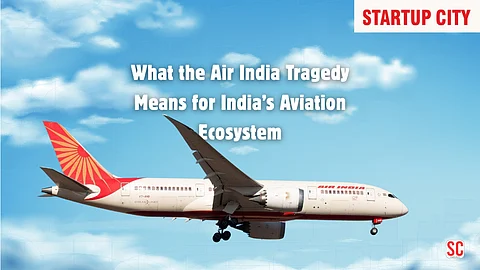

The catastrophic crash of Air India’s Flight AI-171, a Boeing 787-8 Dreamliner, shortly after take-off from Ahmedabad on June 12 has left the country in shock. With more than 260 lives lost and widespread media coverage, the tragedy has already begun to reshape India’s aviation landscape in tangible and lasting ways.
While the cause of the crash is still under investigation, the implications are already playing out across regulatory scrutiny, operational strategy, investor sentiment, and insurance liabilities. For business leaders watching the aviation sector, the incident is both a crisis and a case study in managing large-scale disruption.
The incident triggered immediate intervention from the Directorate General of Civil Aviation (DGCA), which launched an enhanced safety inspection of Air India’s 33 Dreamliner aircraft. Though no systemic failure was found, operational limitations followed swiftly—causing cascading effects on flight schedules, customer trust, and market behavior.
From 90 wide-body flights a day on June 12, Air India’s schedule plummeted to 55 daily flights by June 17. Dreamliner-specific operations were scaled down from 50 to 30. These disruptions hit key international routes and left thousands of passengers rebooked, delayed, or stranded.
In its statement issued on June 17, the DGCA confirmed that inspections revealed no major safety concerns in the Dreamliner fleet. Maintenance systems and procedures were found compliant with existing norms. However, the regulator also used this moment to raise red flags.
Air India was advised to:
Improve internal coordination across operations, engineering, and ground services.
Ensure availability of critical spare parts to avoid service delays.
Strengthen passenger communication and comply strictly with operational regulations.
In parallel, DGCA also reviewed performance data from wide-body routes and asked the airline to adopt alternate routing to counter delays from the Iran airspace closure, which has compounded network stress.
Though Air India remains unlisted, its crash has affected aviation-related stocks and could influence the timing and trajectory of its anticipated IPO. Meanwhile, investor concerns extended to the broader sector:
IndiGo, SpiceJet, and travel ecosystem companies like Ixigo and Indian Hotels registered a mild decline post-crash.
Boeing’s stock dipped nearly 5%, renewing global scrutiny of the Dreamliner line.
For financial markets, the tragedy revived familiar questions: How resilient are airline operations under pressure? What accountability do manufacturers bear in post-sale support? And how do reputational risks translate into financial exposure?
The incident is poised to become one of the most expensive aviation claims in recent Indian history. Industry estimates place total insurance exposure between ₹1,600 crore to ₹4,000 crore ($200M–$475M), covering:
Full hull loss of the Boeing 787-8 aircraft
Passenger liabilities as per the Montreal Convention
Third-party claims, including damage to BJ Medical College, into which the aircraft crashed
A large portion of these liabilities is expected to be passed on to international reinsurers, possibly leading to premium hikes across the Indian aviation insurance market in 2026.
The DGCA has sought training records for the flight’s pilots and dispatchers, which could determine if regulatory or procedural lapses contributed to the crash. Legal experts warn that if negligence is proven, liabilities may exceed the current $1.5 billion insurance coverage and open the door to punitive damages.
Rebuilding trust among passengers, regulators, investors, and global partners will require a deliberate and transparent overhaul of safety narratives and operational integrity at Air India.
Here’s how the crash is rippling across the aviation value chain:
Flight Operations- 6+ aircraft grounded; cut in daily Dreamliner schedules
Investor Confidence- Air India IPO outlook dims; sector-wide caution in trading
Insurance Sector- Spike in reinsurance claims; tougher renewal environment
Regulatory Pressure- Increased audits, coordination demands, stricter oversight
Brand & Legal Risk- Reputational damage; possible legal and financial overhang
The DGCA’s finding of no systemic lapse offers short-term relief, but it does not erase the deeper issues the crash has exposed. For Air India—and by extension, India’s aviation ecosystem—the road to recovery must include more than inspections. It must involve:
Transparent communication
Strengthened risk management
Continued investment in training and maintenance systems
Reinforced regulatory frameworks
In a global industry where safety and reliability are paramount, the Air India crash is a painful reminder of how quickly things can unravel—and how urgently they must be addressed. As airlines regroup, insurers recalibrate, and regulators reassert control, this moment may well define the next era of Indian aviation.
The real test, however, lies not in how the system responds to crisis, but in how it prepares to prevent the next one.